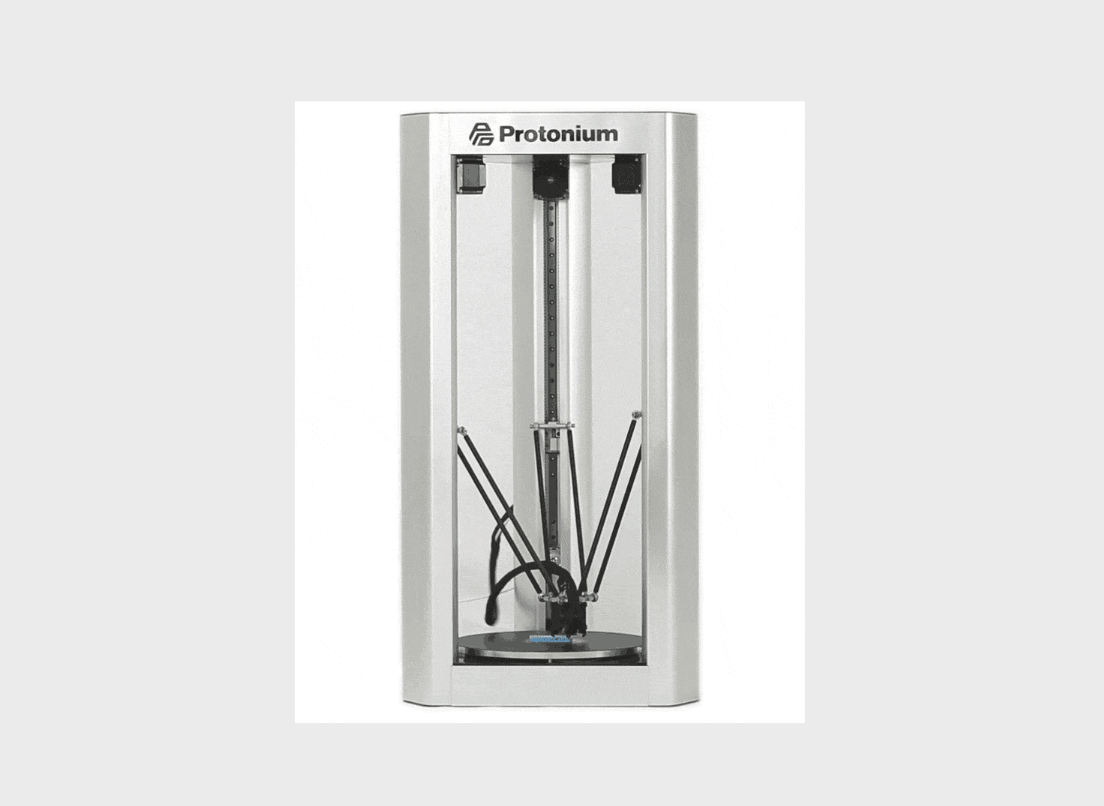
Among numerous crowdfunded 3D printers currently running is one that might be of interest: the Protonium.
The Protonium is a professional desktop 3D printer using the delta-style approach to plastic extrusion. It’s available in either a 260mm diameter by 300mm tall, or 365mm by 500mm tall cylindrical configurations. Big, as most delta machines are.
But build volume is not the interesting feature on this machine. No, it has to do with print speed and quality.
The Protonium is designed for high speed 3D printing. It includes a very robust all-metal frame to resist vibrations. It has an “Industrial-grade high torque stepper motor” that can deliver plastic at a fast rate to the hot end, which sports “symmetrical double heaters” for rapid heating.
These components apparently permit the device to 3D print at a ridiculous rate of “up to 750mm/second”, which I find hard to believe. That would be only under ideal conditions and printing in a straight line with no turns or stops.
In the practical world, Protonium claims their machine can 3D print at a rate approximately 2.4X faster than typical machines. This, I believe.
In fact, you can see in this 26 minute realtime video a print taking place, where the printer movements are indeed quite rapid.
The Protonium also claims to produce part with higher strength and higher isotropy. For those not familiar with isotropic properties, it simply means that the layer gaps, which are typically the weakest part of the 3D print, are stronger. A fully isotropic part would have equal strength in all directions.
I’m a bit baffled as to how they achieve this, as the system appears to be similar in design to many other 3D printers. Here’s their explanation:
It is not a conventional desktop 3D printer that can print nothing but delicate prototypes for fun, but a professional 3D printer that is capable of printing functional prototypes that perfectly meet strength and resolution requirements for designing and engineering.
and
With higher printing speed, especially the infill speed, the temperature of printing surface can be easily maintained at a higher level, which creates firm combinations between each layer and brings better microstructure and crystallinity. That’s why those prototypes printed by Protonium can reach high strength.
I think what this is saying is that they are extruding at a higher temperature, which isn’t surprising given their printing speed: a higher temperature makes the plastic less viscous and easier to push out the nozzle.
If that’s the case, then perhaps the higher temperature plastic does form better adhesion with the previous layer. So this claim may be true.
The Protonium is also capable of very high resolution. Apparently they can used a 0.2mm nozzle, one of the smallest I’ve heard of, to achieve layer sizes of only 0.0125mm, about a quarter of the typical finest resolution possible on other machines. This means your prints will take a bit longer because of the additional number of layers, but at least the printing of them could be 2.4X faster.

They also offer an add-on laser engraving unit, which I suspect won’t draw much interest. It’s only 2.3W, so it cannot do much work without running extremely slowly.
Pricing of this machine is not bad, at only USD$1,699 for the early birds on their Kickstarter campaign. Their normal price is said to be USD$2,999, so the 40% discount on the launch is pretty good.
That all said, I must remind all readers that Protonium is a startup company based in China (at least that’s where their domain name registrant is located). I have to say their campaign is somewhat lacking in detail that can provide confidence in their project, as they provide no details of who they are, or what their manufacturing experience might be. In fact, there are no names listed, or even a business address. Those are basic items that should provide some additional confidence that the project will go forward.
Via Kickstarter and Protonium

